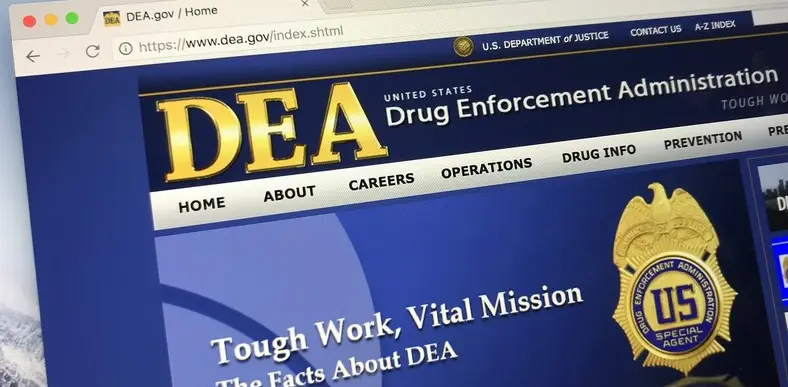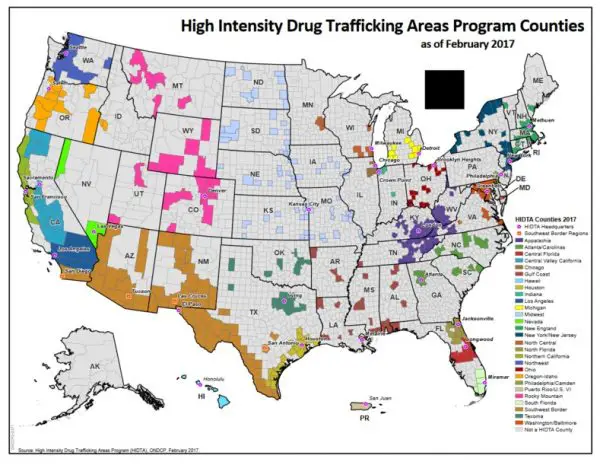A Look at the Northwest High Intensity Drug Trafficking Area

Trafficking drugs is a serious public health concern. Addiction in Washington state has reached crisis levels. The opioid crisis is at epic proportions and meth misuse continues to spread. Cocaine is back along with the more lethal opioid synthetics like fentanyl.
A 2016 report showed nearly 600 opioid-related deaths in the state. While King, Kittitas, Pierce and Spokane counties increased their needle exchanges by 19 percent, there were still 70 deaths related to fentanyl alone in 2016, doubling from the prior year. The same report showed deaths from methamphetamine increased 72 percent from 2010 to 2015.
To try to slow the pace of substance use disorders in Washington state, lawmakers joined forces with the federal government to designate 14 counties as High-Intensity Drug Trafficking Areas (HIDTA). A HIDTA designation allows state and local officials to create a consortium of concentrated resources in areas where drug trafficking is widespread.
What Is HIDTA and How Does It Impact Washington State Addiction Treatment?
In response to around-the-clock efforts to stop substance use disorders, the U.S. government joined with local law enforcement and the clinical treatment community to create the Northwest HIDTA in 14 Washington state counties:
- Benton
- Clark
- Cowlitz
- Franklin
- King
- Kitsap
- Lewis
- Pierce
- Skagit
- Snohomish
- Spokane
- Thurston
- Whatcom
- Yakima
The HIDTA designation seeks to bring together resources and focus efforts to slow down the spread of drug trafficking in these regions.

The Drug Enforcement Administration (DEA) is the agency behind the HIDTA designation, which was originally created as a Congressional mandate in the 1988 Anti-Drug Abuse Act. The goal of HIDTA is to provide additional resources to fight drug trafficking anywhere the status is applied. This grant program has an annual budget of roughly $280 million.
The DEA’s website states that concentrating resources in HIDTA communities will ultimately reduce the volume of illegal drugs in the state. The tactics for achieving this goal include:
- Coordinating and facilitating cooperation between federal, state, local and tribal law enforcement agencies
- Enhancing law enforcement intelligence sharing between these entities
- Using this data to create effective law enforcement strategies
Counties that qualify as HIDTA must meet the following criteria as outlined on the DEA website:
- The area contributes a significant amount of illegal drugs to the market by manufacturing, importing and trafficking
- Local officials must have skin in the game toward stopping drug trafficking in the area
- The efforts of local officials are failing and the numbers surrounding illegal drug use are increasing
- Statistics show drug trafficking is having a significantly negative effect on the region
Once HIDTA has been designated, additional resources can be applied. Coordination of these resources is primarily through the Office of the National Drug Control Policy (ONDCP). However, local administrative boards oversee the work of law enforcement and the clinical community in the region.
This board reports back to the ONDCP by providing four key metrics:
- A report that shows an updated threat assessment of drug trafficking in the region as well as the human and economic costs of these activities
- A strategy for how the HIDTA regions will address these threats
- A budget proposal with funding needs for carrying out these plans
- A report detailing how each county impacted drug trafficking in the region
HIDTA funding supports six types of initiatives:
- Legal enforcement
- Intelligence and information sharing
- Program support
- Prevention programs
- Treatment programs
- Management of these initiatives
- Treatment activities
These federal funds cannot be used to expand or establish new drug treatment programs, but up to 5 percent of the overall regional budget can be applied to establish effective drug prevention programs.
Washington State Addiction Treatment and HIDTA
The Northwest HIDTA says their initiatives combine many law enforcement and demand reduction initiatives into a single approach to combat the drug threat in the Pacific Northwest. Their efforts focus on five areas:
- Intelligence
- Investigations
- Interdiction
- Education
- Prevention
Within the 14-county HIDTA in Washington State, there are a number of initiatives, including:
- The Washington State Patrol (WSP) Pro-Active Methamphetamine Team focuses on illegal labs around the state. The WSP responds to nearly 50 percent of all the illicit meth labs in the HIDTA.
- The Thurston County Narcotics Task Force, which focuses on some of the most significant drugs, such as meth, heroin and cocaine
- HIDTA Tacoma Region Task Force coordinates the efforts of the DEA, the Tacoma Police and the Pierce County Sheriff’s Office to battle traffickers of meth, heroin and cocaine
- Snohomish County Regional Narcotics Task Force focuses on drug trafficking organizations operating in Snohomish County
- The Northwest HIDTA Border Task Force that fights drug smuggling on the US/Canadian border
- Northwest HIDTA Yakima County Task Force, which uses an encrypted microwave communications system in this primarily rural area to link three task forces working in a region that is roughly 40 miles long
- The Investigative Support Center brings together several agencies to combine intelligence and post-seizure analysis, training and more
Addiction treatment programs benefit from the HIDTA designation by receiving grant monies to improve their outreach prevention to at-risk communities. Some of the HIDTA-sponsored initiatives that have benefited these organizations include:
- Community Coalition Support Initiative provides resources to substance abuse prevention coalitions in the HIDTAs
- Drug Court Development works to provide support to drug court programs in each of the HIDTAs. The ONDCP says the goal is to offer guided treatment “to chronic, career drug offenders who are to be adjudicated for drug-related crimes.”
The outcomes of HIDTA have included additional resources to fight drug trafficking, better coordination between siloed law enforcement programs, increased awareness and a reduction in illegal drug trafficking. When coupled with strong resources from the Washington state addiction community, the HIDTA designation has become an important method for pooling resources in efforts to stop drug trafficking and ultimately help people with substance use disorders.
Where to Find Help for Addiction
Whether you live in an area designated as a high-intensity drug trafficking area or in a surrounding area, there are resources available to you if you experience a substance use disorder. Contact The Recovery Village Ridgefield to learn more about our residential treatment facility.

